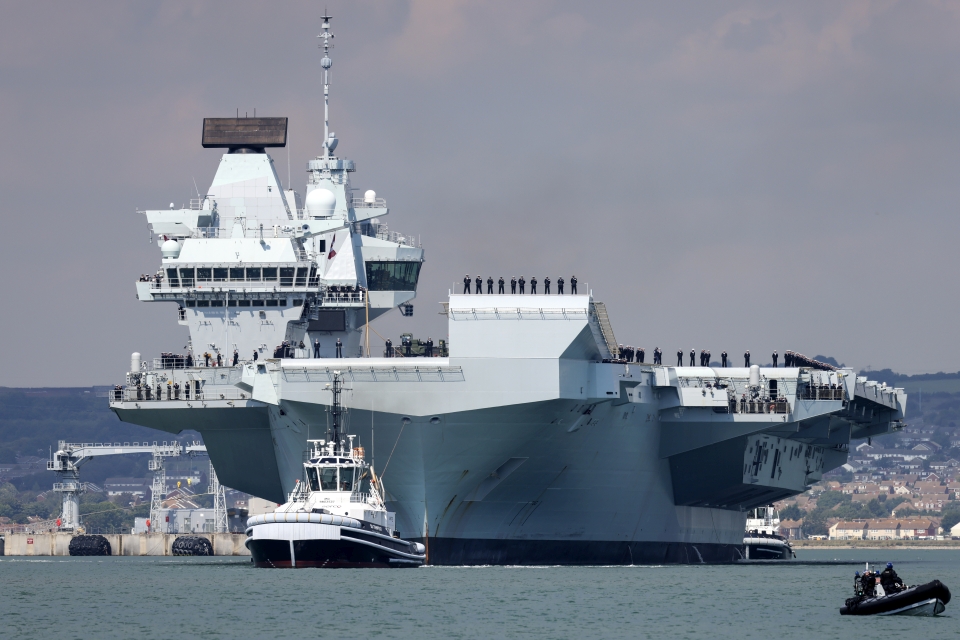The Royal Navy aircraft carrier HMS Prince of Wales has left Portsmouth and is heading for Rosyth for work on its starboard propeller shaft. The shaft suffered a mechanical defect as the ship left for New York last month.
Inspections by divers revealed the shaft coupling had failed. The fastest and safest way to repair it and return the ship to operations will mean the carrier will enter dry dock in Rosyth, one of the few yards capable of accommodating the 65,000-tonne warship.
Since the aircraft carrier returned to Portsmouth Naval Base in early September, the ship’s engineers have been working with divers and expert naval architects and engineers from Babcock – who run the dockyard at Rosyth – and the Ministry of Defence’s Defence Equipment and Support organisation to work out what is needed to return HMS Prince of Wales back to operations.
Also read: HMS Prince of Wales in need of dry dock to fix propeller shaft, HMS Queen Elizabeth to fill in
Unclear when vessel can resume operations
However, the extent of and the timescale for the repairs will not be fully known until the ship is in dry dock and has been thoroughly inspected by engineers, but the goal is to return HMS Prince of Wales to front-line operations as quickly and safely as possible.
‘Now that the initial engineering challenges have been overcome to allow us to sail, we will transit to Rosyth where we will continue to work hard with our industry partners in the dockyard to ensure the shaft is repaired as quickly as possible and return HMS Prince of Wales to the front line to continue her operations,’ says Captain Richard Hewitt.
Simulator training for journey
In the meantime the 33-tonne starboard propeller was removed ahead of its journey to the Firth of Forth.
To prepare for the return to Rosyth, where the carrier was assembled between 2011 and 2017, the carrier’s navigation team have trained on a simulator alongside Forth pilots and tug captains at South Shields Marine School at the South Tyneside College to practise the approach to anchorage and sailing under the three Forth bridges and into the dry dock.
Lieutenant Commander Chris Poulson, HMS Prince of Wales’ Navigator: ‘Returning Prince of Wales back into the dock in which she was assembled will be a big navigational challenge. We of course know that she will fit, but it will be a huge team effort between the ship’s company, the Forth Pilots, the team ashore from Babcock and the towage company to get her in to the dock.’
Also read: Royal Navy’s aircraft carrier HMS Prince of Wales breaks down shortly after departure
Training to continue
The ship has sailed with a full complement of crew – 750 men and women – who will remain with the ship and continue training for renewed operations as well as supporting the maintenance package while in Rosyth.
While alongside in Rosyth, they will continue to crew and train on the ship’s systems for their operational roles while also taking advantage of the Scottish landscape to undertake leadership and adventurous training activities during the autumn and winter months.
While under repair, the autumn programme that included operating with F35B lightning, MV22 Osprey and UAVs off the Eastern Seaboard of the USA is currently being rescheduled for 2023.
HMS Prince of Wales
HMS Prince of Wales is the second of the Royal Navy’s two aircraft carriers of the Queen Elizabeth class. The 65,000-tonne vessels are the largest in the Royal Navy.
The issue with the starboard propeller was discovered shortly after departure from Portsmouth on Saturday, 27 August. The vessel was headed to the US for a training mission. These tasks were taken over by the Royal Navy’s other aircraft carrier, the HMS Queen Elizabeth.
Picture by the UK Ministry of Defence.
Also read: Damen Shipyards delivers vessel to the Royal Navy for the first time








